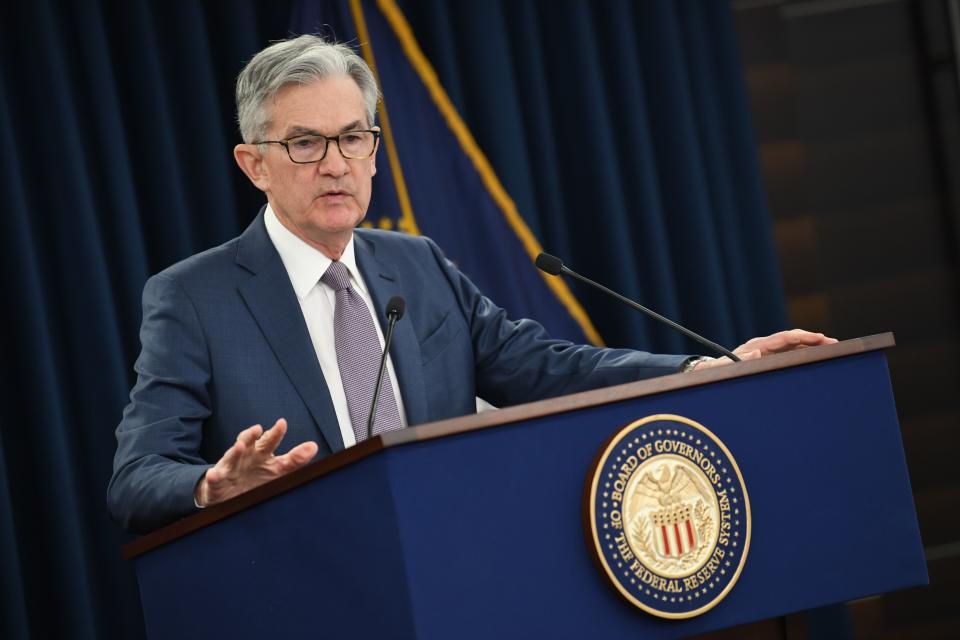'Talk ourselves into a recession': Bank in coronavirus hotspot has doubts over Fed rate cut
The Federal Reserve slashed interest rates by half a percentage point last week, citing a need to protect small- to medium-sized businesses from the economic ripple effects of the coronavirus.
But a Seattle-based regional bank doubts that lower interest rates will build confidence in a community grappling with its own coronavirus outbreak. In the suburb of Kirkland, Washington, an outbreak at a nursing facility led to 13 deaths alone as of Saturday.
WaFd Bank operates a branch a mile away from the Life Care Center, and WaFd CEO Brent Beardall says the rate cut gives “credence to the kind of panic” reminiscent of 2008.
“The reality is, there was no crunch on credit where credit wasn’t available last week before the Fed cut,” Beardall told Yahoo Finance. “Businesses in Kirkland that needed lending capacity, it was there and available to them. And today it’s a little bit cheaper but what does 50 basis points really do? I’m not sure it does that much.”

Banks may feel the squeeze in the interim. Houston-based Cadence Bancorporation told investors hours after the rate cut that the bank is confident in its ability to navigate the choppy waters of Fed policy but warned that the industry may not.
“Today's rate cut for many banks is bad news,” said CEO Paul Murphy Jr. on Tuesday.
Charles Peabody, a bank analyst at Portales Partners, told Yahoo Finance’s On the Move that he already expected banks to report flat revenue growth for the year, but now expects net interest income to decline as a result of the rate cut.
“It’s more about protecting the economy at the expense of the banks,” Peabody said on Wednesday.

On Tuesday morning, the Fed abruptly cut interest rates to a target range of between 1.00% to 1.25%. Fed Chairman Jerome Powell billed the cut as a way to avoid a tightening of financial conditions while supporting household and business confidence.
“We do believe that our action will provide a meaningful boost to the economy,” Powell said.
But with equities extending their sell-off, credit spreads widening, and Treasury yields hitting new all-time lows, the rate cut does not appear to have steered clear of tightened financial conditions.
And with doubts over the effectiveness of a 50 basis point cut on main street, attention is now shifting to other tools that the Fed could use to support the U.S. consumer and small- to medium-sized businesses.
What can the Fed do?
Fed officials say they hope to relieve stress on small businesses across the country that not only provide goods and services to consumers, but serve as employers in their communities.
Cleveland Fed President Loretta Mester said Tuesday she supported the 50 basis point cut to “provide relief to workers and smaller businesses that are affected by the pullback in activity.”
But the Fed has other tools that could have addressed small businesses that may face a revenue and cash crunch amid coronavirus-induced disruptions.
During the financial crisis, the Fed was able to provide credit and liquidity directly to businesses through a Term Asset-Backed Securities Loan Facility, in cooperation with the Treasury.
However, Goldman Sachs noted March 5 that such a facility could only be used “under very extreme market conditions,” and pointed out that post-crisis rules under the Dodd-Frank law narrowed the type of programs it could offer in the future.
Regulatory guidance
As one of three primary banking regulators, the Fed can offer small forms of relief to banks dealing with operational problems that could arise in an outbreak. For example, regulators could encourage banks to work with troubled borrowers to offer loan modifications and clarify that bank examiners should expect slightly looser loan standards in the interim.
“The supervisors will be working with banks to assure that they work with their borrowers and that sort of thing,” Powell said Tuesday. “I can imagine us doing those sorts of things, but those things are not upon us at the moment."
Another example: Banks are generally required to give regulators 90 days notice ahead of closing a branch location. But provisions allow a bank to shorten that window of notice to three days in the event of an emergency.
On Friday, the Fed, the Federal Deposit Insurance Corporation and the Office of the Comptroller of the Currency issued updated guidance for banks advising them on how to plan for a possible pandemic.
At WaFd Bank, Beardall said his bank is already tackling both operational challenges. Businesses have proactively reached out to the bank to brainstorm plans to continue to pay their loans. But Beardall said there are few businesses that are “teetering” on failure.

Beardall said in the end, he wishes the Fed was more patient before cutting rates.
“My biggest fear is, because of the perception that everybody needs to grind to a halt, we will essentially talk ourselves into a recession,” Beardall said. “People will stop going out to eat, people will stop traveling and everything and then it becomes a self-fulfilling prophecy.”
As for WaFd itself, the company has shuttered the lobbies of several branch locations to limit person-to-person contact, but branches remain open to customers via drive-thrus and ATMs.
Brian Cheung is a reporter covering the Fed, economics, and banking for Yahoo Finance. You can follow him on Twitter @bcheungz.
Boston Fed President: Quantitative easing may not work as well next time
Fedspeak amid coronavirus: From don't 'overreact' to 50 basis point cut
Trump's banking regulator to critics of community lending reform: 'Bring it on'
Coronavirus fears raise market expectations for Fed rate cut in March
'We are all competing': Los Angeles finds new ways to tackle labor shortage
Read the latest financial and business news from Yahoo Finance
Follow Yahoo Finance on Twitter, Facebook, Instagram, Flipboard, SmartNews, LinkedIn, YouTube, and reddit.

 Yahoo Finance
Yahoo Finance 